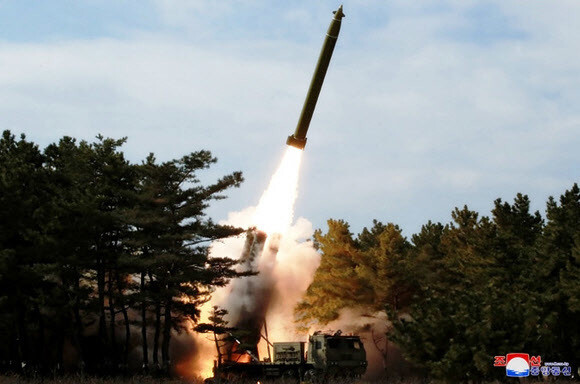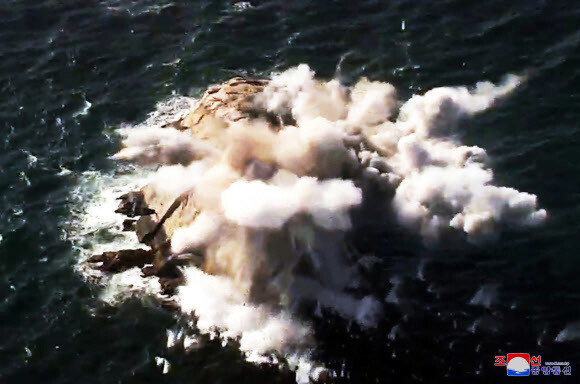hankyoreh
Links to other country sites 다른 나라 사이트 링크
N. Korea releases images of firepower “strike drill”

On Mar. 3, North Korea unveiled images of a projectile launch, part of what it claimed to be a firepower “strike drill” under the direction of leader Kim Jong-un. Observers in and around the South Korean military said the weaponry appeared similar to the “super-large multiple rocket launcher” fired on four different occasions last year. The Joint Chiefs of Staff announced that it had observed two short-range projectiles launched the day before toward the East Sea from the Wonsan area.
In a front-page story in its Mar. 3 edition, the Rodong Sinmun wrote that Kim Jong-un had “guide[d a] firepower strike drill of long-range artillery sub-units of [the Korean People’s Army] on [the] front.”
“As he ordered the sub-units to fire, the men operating multiple-rocket launchers opened fire all at once,” the article said.
The article contained no mention of South Korea or the US, suggesting that the launch was part of a drill focused on emphasizing a “thorough military readiness posture.” Kim “expressed great satisfaction” after guiding the drill, the Rodong Sinmun reported. He was accompanied by KPA General Park Jong-chon.
In the images released by North Korea on Mar. 3, the four cylindrical launch tubes mounted on a transporter erector launcher and the projectiles being fired into the air resemble the previously fired super-large multiple rocket launcher. The super-large multiple rocket launcher’s cylindrical launch tubes were previously estimated at around 600mm in diameter. In addition to images of the projectile launch, North Korea also shared photographs of firing with a 240mm multiple rocket launcher, suggesting that both types were used in the firepower strike drill.

North Korea fired its super-large multiple rocket launcher a total of four times last year on Aug. 24, Sept. 10, Oct. 31, and Nov. 28. In each case, two rounds were fired at respective intervals of 17 minutes, 19 minutes, three minutes, and 30 seconds. The latest interval was calculated at 20 seconds, indicating a 20-second decrease from the previous launch. In contrast with the previous launches, North Korea did not refer to the drill as a “test launch,” leading some observers to speculate that the super-large multiple rocket launcher may have been deployed into combat position.
“We have no way of knowing whether North Korea has completely resolved the technical issues with successive launches, but there have been a number of cases in the past where North Korea skipped over that process to place a new weapons system into combat position,” a South Korean military official said.
In a photograph, artillery smoke can be seen over an island that appears to have been hit by a multiple rocket launcher round. The smoke covers a wider area than in previous launches.
Analysts said that if the smoke is indeed the result of North Korea landing a precise strike on the island with its super-large multiple rocket launcher, a cluster bomb unit could have been placed on the warhead. A cluster bomb unit causes wide-ranging explosions by distributing submunitions from the sky over its target. But with no specific reference made to the island’s position or the weapon used to strike it, observers are saying it could also have been struck with multiple 240mm multiple rocket launcher rounds at the same time.
By Yoo Kang-moon and Lee Je-hun, senior staff writer
Please direct comments or questions to [english@hani.co.kr]

Editorial・opinion
![[Column] Life on our Trisolaris [Column] Life on our Trisolaris](https://flexible.img.hani.co.kr/flexible/normal/500/300/imgdb/original/2024/0505/4817148682278544.jpg) [Column] Life on our Trisolaris
[Column] Life on our Trisolaris![[Editorial] Penalties for airing allegations against Korea’s first lady endanger free press [Editorial] Penalties for airing allegations against Korea’s first lady endanger free press](https://flexible.img.hani.co.kr/flexible/normal/500/300/imgdb/original/2024/0502/1817146398095106.jpg) [Editorial] Penalties for airing allegations against Korea’s first lady endanger free press
[Editorial] Penalties for airing allegations against Korea’s first lady endanger free press- [Editorial] Yoon must halt procurement of SM-3 interceptor missiles
- [Guest essay] Maybe Korea’s rapid population decline is an opportunity, not a crisis
- [Column] Can Yoon steer diplomacy with Russia, China back on track?
- [Column] Season 2 of special prosecutor probe may be coming to Korea soon
- [Column] Park Geun-hye déjà vu in Yoon Suk-yeol
- [Editorial] New weight of N. Korea’s nuclear threats makes dialogue all the more urgent
- [Guest essay] The real reason Korea’s new right wants to dub Rhee a founding father
- [Column] ‘Choson’: Is it time we start referring to N. Korea in its own terms?
Most viewed articles
- 1New sex-ed guidelines forbid teaching about homosexuality
- 2OECD upgrades Korea’s growth forecast from 2.2% to 2.6%
- 360% of young Koreans see no need to have kids after marriage
- 4[Column] Life on our Trisolaris
- 5Months and months of overdue wages are pushing migrant workers in Korea into debt
- 6Korean government’s compromise plan for medical reform swiftly rejected by doctors
- 7[Guest essay] Maybe Korea’s rapid population decline is an opportunity, not a crisis
- 8S. Korea discusses participation in defense development with AUKUS alliance
- 9Presidential office warns of veto in response to opposition passing special counsel probe act
- 10Inside the law for a special counsel probe over a Korean Marine’s death